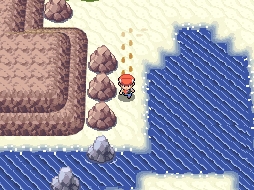Mystery Zone: Difference between revisions
No edit summary |
|||
| Line 32: | Line 32: | ||
In the [[Generation V]] games, inacessible sections of areas use the header and background music of the location from which they were entered. For example, in {{game|Black and White|s 2|Pokémon Black 2 and White 2}}, if the player keeps heading north of {{rt|19|Unova}}, going outside the boundaries of the map, the game will still recognize the location as being "Route 19" until the player arrives at another normally accessible location. | In the [[Generation V]] games, inacessible sections of areas use the header and background music of the location from which they were entered. For example, in {{game|Black and White|s 2|Pokémon Black 2 and White 2}}, if the player keeps heading north of {{rt|19|Unova}}, going outside the boundaries of the map, the game will still recognize the location as being "Route 19" until the player arrives at another normally accessible location. | ||
The "Mystery Zone" in these generations is completely unused. The {{pkmn|Egg}} received through the {{DL|List of glitches in Generation VI|Bad Egg/Mystery Egg occurrence}} in {{g|X and Y}} | The "Mystery Zone" header (<code>0x0001</code> in Generation V, <code>0x0002</code> in [[Generation VI]]) in these generations is completely unused. The {{pkmn|Egg}} received through the {{DL|List of glitches in Generation VI|Bad Egg/Mystery Egg occurrence}} in {{g|X and Y}} uses this caught/obtained location ID. | ||
The Generation V equivalent to [[Generation IV]]'s '''SEQ_DUMMY''' music theme is called '''SEQ_BGM_DUMMY''' and is a copy of ''[[Pokémon Black & Pokémon White: Super Music Collection|Icirrus City]]''. | The Generation V equivalent to [[Generation IV]]'s '''SEQ_DUMMY''' music theme is called '''SEQ_BGM_DUMMY''' and is a copy of ''[[Pokémon Black & Pokémon White: Super Music Collection|Icirrus City]]''. | ||
Revision as of 23:43, 29 September 2015
- This article is about the header. For the homonymous card from the Skyridge expansion, see Mystery Zone (Skyridge 137).
| This glitch is in need of research. Reason: Clarification of details. You can discuss this on the talk page. |
The Mystery Zone (Japanese: なぞの場所 Mystery Zone) is a location header that is programmed into every core game since Generation IV.
Generation IV
In the Generation IV games, location ID 0x0000 "Mystery Zone" is usually seen in some of the areas found in the void but it is also used for certain unused locations as well as the Underground.
The Japanese versions of Pokémon Platinum, HeartGold and SoulSilver identify the undefined areas as ----; however, they still identify a Pokémon's caught location set to the Mystery Zone as なぞのばしょ. This is because the two are different location IDs that share the name "Mystery Zone" in English games; whereas 0x0000 ---- is used for map IDs, 0x07DC なぞのばしょ is used for caught Pokémon. However, since no Pokémon are found in Mystery Zones, this ID goes unused.
Access
The Mystery Zone is normally inaccessible, but can be entered by means of tweaking. In earlier copies of the Japanese versions of Pokémon Diamond and Pearl, the Surf glitch is an alternative method. It can also be accessed with the use of cheating devices.
Music
In Pokémon Diamond, Pearl, and Platinum, the background music theme is usually the unused copy of Route 206 (Day), which is identified internally as SEQ_DUMMY.
| |
In Pokémon HeartGold and SoulSilver, the background music theme is also SEQ_DUMMY but it is a copy of Route 29 instead. It is not affected by the GB Sounds.
Behaviors

Upon entering a map ID 0 "Mystery Zone" and accessing a location with a different map ID, the tilesets will not be updated even if the new area is programmed to use a different tileset. Simply refreshing the graphics will solve this. Sinnoh's Mystery Zone has its own tileset which can be seen by entering it from the overworld, refreshing the graphics there, and then returning to the overworld. This tileset is actually a slightly distorted depiction of the tileset shown in a pre-release screenshot of Pokémon Diamond and Pearl, indicating that it is a leftover from the development period. It also remains within the internal data of Pokémon HeartGold and SoulSilver.
On the 1.0 release of the Japanese versions of Diamond and Pearl, both the menu and the Explorer Kit are usable in a Mystery Zone. On later releases, the localizations, and Pokémon Platinum, neither the menu or the Explorer Kit can be opened (in HeartGold and SoulSilver, the touchscreen menu is locked), although a registered key item like the Town Map can still be used to refresh the graphics in the area at any time.
| |
| |
Later generations
In the Generation V games, inacessible sections of areas use the header and background music of the location from which they were entered. For example, in Pokémon Black 2 and White 2, if the player keeps heading north of Route 19, going outside the boundaries of the map, the game will still recognize the location as being "Route 19" until the player arrives at another normally accessible location.
The "Mystery Zone" header (0x0001 in Generation V, 0x0002 in Generation VI) in these generations is completely unused. The Egg received through the Bad Egg/Mystery Egg occurrence in Pokémon X and Y uses this caught/obtained location ID.
The Generation V equivalent to Generation IV's SEQ_DUMMY music theme is called SEQ_BGM_DUMMY and is a copy of Icirrus City.
In other languages
| |||||||||||||||||||||
See also

|
This article is part of both Project Locations and Project GlitchDex, Bulbapedia projects that, together, aim to write comprehensive articles on locations and glitches, respectively. | 
|